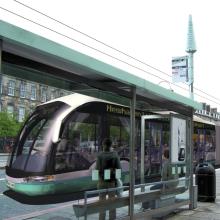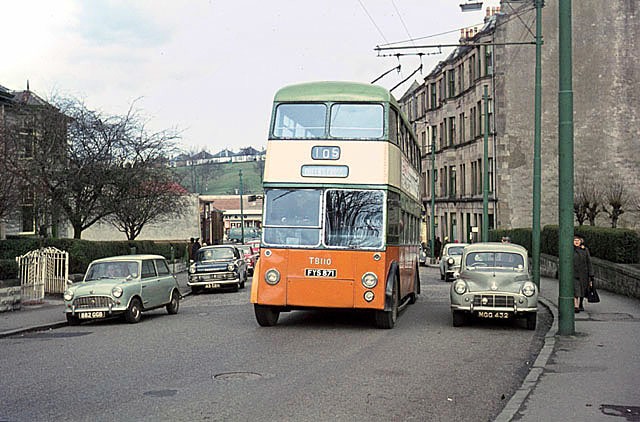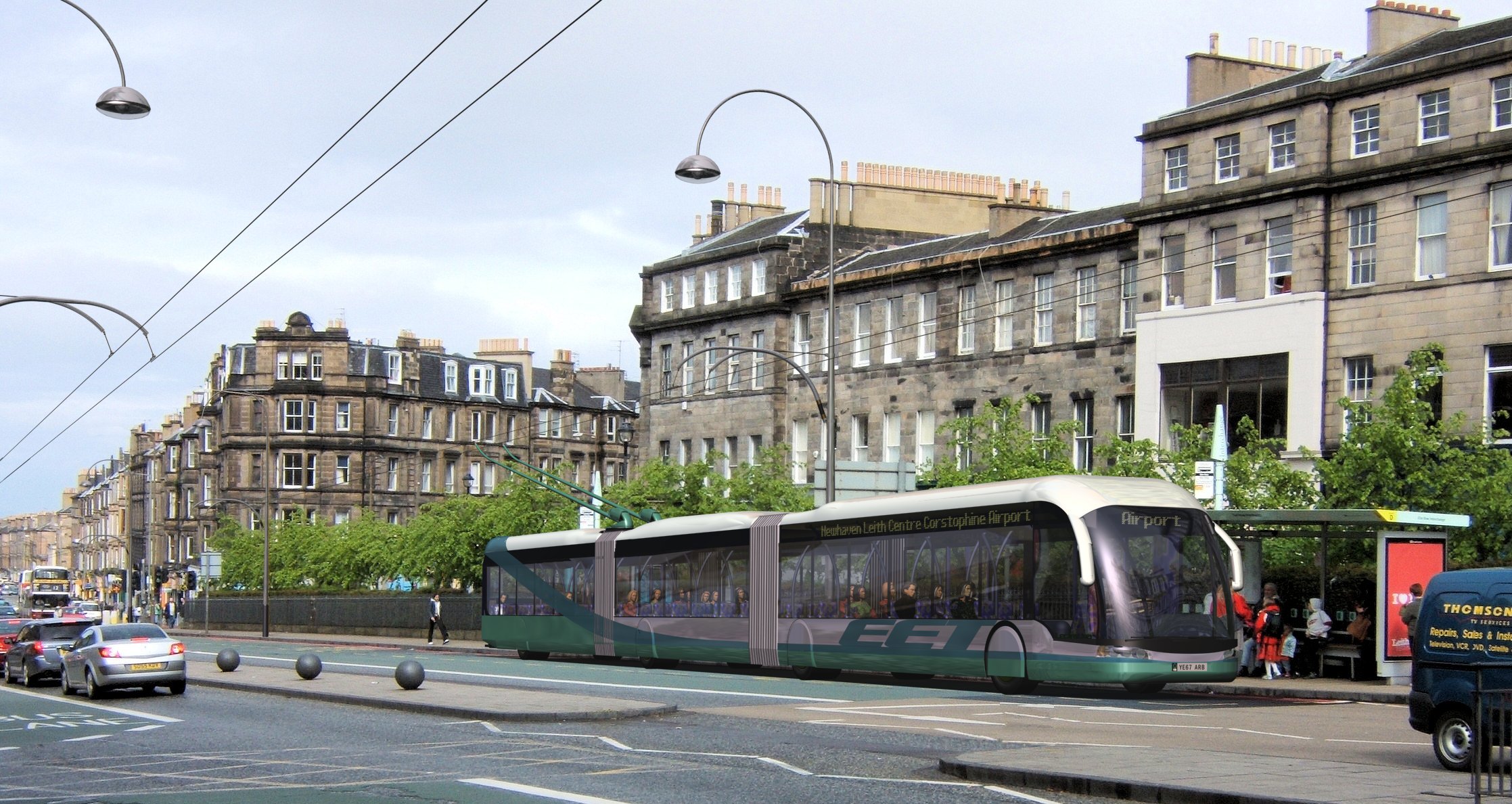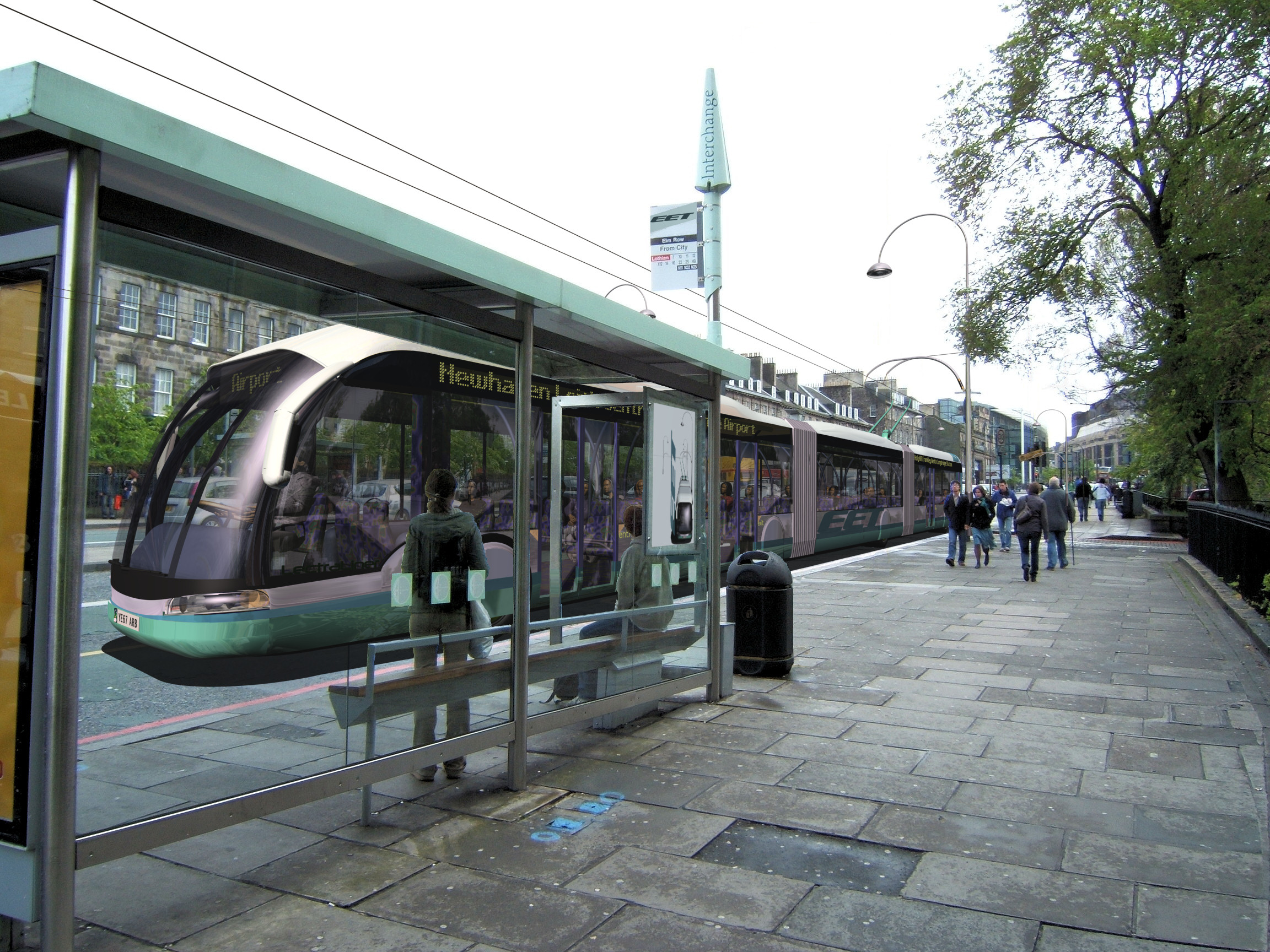
ARE TROLLEYBUSES A SERIOUS OPTION FOR EDINBURGH'S PUBLIC TRANSPORT NEEDS?
David Sterratt reflects on what could have been – and perhaps still can be.
Lest I be called a dog-in-a-manger, I love Edinburgh’s trams. I love travelling on them. Seeing them snake smoothly around the corner of St Andrew Square and York Place sends a shiver down my spine. They have the ambience of a proper metro system and the bell’s 'glong' fills me with civic pride.
However, when Left Unity candidate Bruce Whitehead mentioned the idea of extending the tram system with trolleybuses at the Spurtle’s General Election hustings in May, I felt vindicated: eight years earlier, trolleybuses had been my hobbyhorse, as I campaigned to get MSPs to consider them as an alternative to the tram system, which was then under threat from the newly elected SNP Government.
I knew about trolleybuses from my grandfather, who had seen them replace trams in the 1930s, and father, who used them to get to school in the 1950s. Trolleybuses offered one of the main benefits of trams – no fumes in the streets – and didn’t need costly and cyclist-unfriendly rails. Why weren’t they being considered?

It turned out that trolleybuses had not been considered as an explicit option in the 2001 Feasibility Study, though a number of much less plausible options (e.g. Monorail, MAGLEV, cable-driven guideway) were considered. In the Edinburgh Tram (Line One) Bill Committee of 22 October 2004, the promoters mentioned trolleybuses in one paragraph:
Trolleybuses were popular during the 1950’s. In Western Europe today only about 40 systems exist and, in some cases, these are outmoded. They have less capacity than trams and can be inefficient and are prone to breakdown and interruption in service which may contribute to a lesser ability to effect modal shift than tram. There are no UK systems at present. The last local authority to operate a system was Bradford where operation ceased in 1972.
Stung into action
This had the whiff of a smear campaign. The best reason given for rejecting trolleybuses was their smaller capacity than trams', but this might be compensated for by running trolleybuses at increased frequency or using pre-purchase ticketing systems to allow fast boarding. It is questionable whether trolleybuses are less reliable than trams. The statements about popularity, number and history of systems are just implications, not solid arguments. Modern trolleybus designs are far from outmoded.
But this was not just an injustice against trolleybuses; it was potentially a big mistake: it would be much easier and cheaper to gradually convert bus routes over to trolleybus operation, until pretty much every Lothian Bus route through the city centre was electric.
I researched with the help of the Tbus group, a dedicated band of trolleybus experts intent on reintroducing trolleybuses in the UK, who have international links to trolleybus cells in Europe, Canada and the US. I set up a website masquerading as a front organisation, Scottish Electric Transit, and sent the briefing on it to every MSP and councillor. I got an article and letters published in the Scotsman and had letters in the Evening News.

One or two joined me and commented valiantly in the comments sections of the Scotsman and Evening News website. But the forces of tram-dom (in the form of the 'Tramfacts' website) were against me: trolleybuses, they claimed, were old-fashioned, couldn’t carry as many passengers as trams, the extra wires would be too unsightly, and Edinburgh couldn’t cope with bendy buses.
The picture on my website showed an image of a sleek double-articulated trolleybus, kindly produced by a member of the Tbus group (see above). This length of bus runs in Zurich, but in the UK we have an aversion to bendy buses, multiple doors and ticketing systems that allow passengers to pile on and off quickly. Of course we could have produced an image of a double-decker with trolley poles on top, but (a) this wouldn’t have had the SFE (sexy front end) and (b) no-one makes double-deckers with poles any more. It’s technically possible, but would probably be more expensive than a bendy trolleybus, which can be bought 'off-the shelf' from a number of European manufacturers.
Had the George Street experiment been running in 2007, I could have said 'There – trolleybus wires are nowhere near as bad as that'. I still think that an extra pair of wires along Princes Street would be barely noticeable compared to the big wheel, 'Edinburgh’s Christmas' and the ensuing conversion of Princes Street Gardens into mudflats. Admittedly the wiring at trolleybus junctions, affectionately known as 'knitting' to appreciative trolleybus nuts, can be extensive and is not to everyone’s taste. But there is quite a lot of it in historic places like Salzburg, and precious few comments on TripAdvisor about it.
To cut a long story short, someone from the SNP did mention trolleybuses on Newsnight Scotland, but then a deal was cut, and the tram scheme – and all it entailed – started. I did a bit more lobbying when the tram scheme was in jeopardy in 2009, but thereafter resigned myself to Edinburgh getting trams.
Throughout the campaign, the emphasis had been on promoting trolleybuses as a potential alternative to trams, not rubbishing trams. With the benefit of hindsight, I wish I had pointed out more of the disadvantages of trams. I didn't know just how disruptive moving utilites and track-laying would be, or how dangerous tram lines could be to cyclists, so I didn't use these as strong arguments against trams. I did highlight that trolleybuses would be cheaper than trams (at the 2007 prices), but I did not predict the trams' cost overruns. In fairness, had the Edinburgh tram design and construction been better managed they would have been cheaper and safer for cyclists, and would have caused less disruption. There are questions - raised on another 'Tramfacts' website - about the effect of the trams on traffic flow and consequent air pollution.
What next?
Back to the present, would it be a good idea extend the tram system with trolleybuses? Somewhat reluctantly, I think the answer is 'no' when it comes to the line to Leith – there is a high population density around Leith Walk to make use of the tram and it would be weird to have to change from tram to trolleybus at York Place: reminiscent of the pre-1928 'Pilrig Muddle' before Edinburgh’s cable-driven trams were electrified and joined up with Leith’s electric system. The loop to the Waterfront, if it’s ever built, should also be completed as a tram line – the route is mostly segregated from roads, which means faster journeys and less conflict with traffic and cyclists.
For the rest of the city’s bus routes, I still believe trolleybuses should be considered, along with other options such as trams and hybrid buses. Assuming trolleybuses follow existing bus routes (many of our current bus routes have the same numbers as the tram routes they replaced, so why not?) we would need to run both trolleybuses and trams along Princes Street, Shandwick Place and Leith Walk. This would mean six wires in total - four trolleybus and two tram - but it happens elsewhere and people don’t seem to mind. We might be able to get away with overhead-free sections (as is done in Rome) by putting bigger batteries in the trolleybuses – but see below.

Futurists will say that trolleybuses will be made obsolete by battery buses in a decade or two, so why bother? The problem with battery buses is … batteries: per unit weight, even the most modern carry a fraction of the energy of diesel fuel, so making a bus with reasonable range means fewer passengers, as they have to make way for the batteries. And like the batteries in smartphones, the traction batteries need replacing every few years. Of course, there are technical innovations galore: better batteries, and ways of charging battery buses at stops via induction pads under the bus (inefficient) or by raising a pantograph to a conductor.
In a few years' time, someone will invent 'continuous charging', where the electric bus is connected for much of its route to two overhead wires, thus avoiding the need for heavy batteries. Perhaps then Edinburgh can have the latest 'continuous charging electric buses'. A rose by any other name would smell as sweet – and certainly sweeter than a diesel bus.

Got a view? Tell us at spurtle@hotmail.co.uk and @theSpurtle and Facebook
----------------------------------------------------------------
Are trolleybuses an option for Edinburgh's public transport needs? http://www.broughtonspurtle.org.uk/news/down-wire-0 … @Tramspotter @jomowat
@theSpurtle @Tramspotter @jomowat @CityCycling - probably not - Volvo has electric buses in Gothenburg and hope to see them here soon 1/2
@DavidSterratt @CityCycling @theSpurtle @Tramspotter diesel/ electric hybrids which charge at end of route so electric through built up area
@DavidSterratt @CityCycling @theSpurtle @Tramspotter Volvo brought one over last year, they're in service in Europe and no wires
@jomowat @CityCycling @theSpurtle @Tramspotter How long have they been in service? How long have the batteries lasted?
@DavidSterratt @jomowat @CityCycling @theSpurtle @Tramspotter don't have technical details - check out volvo's website or Gothenburg bus
 Chris Malcolm The size of batteries for electric buses depends on how long they have to run on them. If the bits of a trolley bus route where the overhead wiring would be complex, unsightly, or expensive, were simply missed out and negotiated on battery only small batteries would be needed. In fact it would have been possible to leave the tram wires off Princes Street if they'd added small batteries to the trams. That would also have given the trams the ability to move into better positions when a power failure occurred.
Chris Malcolm The size of batteries for electric buses depends on how long they have to run on them. If the bits of a trolley bus route where the overhead wiring would be complex, unsightly, or expensive, were simply missed out and negotiated on battery only small batteries would be needed. In fact it would have been possible to leave the tram wires off Princes Street if they'd added small batteries to the trams. That would also have given the trams the ability to move into better positions when a power failure occurred.
 William Kay Yes this is done in Seville, Spain and the pantograph drops while the tram runs through the centre of the city. Some other places have trams that draw the current from below, notably Dubai.
William Kay Yes this is done in Seville, Spain and the pantograph drops while the tram runs through the centre of the city. Some other places have trams that draw the current from below, notably Dubai.
 Bruce Whitehead Excellent article on extension of the tram network using trolleybuses which don't need tracks, and can use the existing wires. David believes tram users would need to change to trolley bus at Yoirk Place, but my idea is for trolleybuses to do that service, while trams concentrate on the central section. The beauty of it is that they can co-exist!
Bruce Whitehead Excellent article on extension of the tram network using trolleybuses which don't need tracks, and can use the existing wires. David believes tram users would need to change to trolley bus at Yoirk Place, but my idea is for trolleybuses to do that service, while trams concentrate on the central section. The beauty of it is that they can co-exist!
 Betty Jourjon I grew up in a town called Saint Etienne in France. It is one of the French city which kept tramways and trolleybus running since they were built (1881 for the tram and 1940 for trolleybus). The use was never interrupted since the constructions lines. To this day, it is the most effective way of city transport. Noise pollution zero, air pollution zero. Every city in France who "killed" this way of transport in the 1960/1970 has now rebuilt the tram lines to great expense.
Betty Jourjon I grew up in a town called Saint Etienne in France. It is one of the French city which kept tramways and trolleybus running since they were built (1881 for the tram and 1940 for trolleybus). The use was never interrupted since the constructions lines. To this day, it is the most effective way of city transport. Noise pollution zero, air pollution zero. Every city in France who "killed" this way of transport in the 1960/1970 has now rebuilt the tram lines to great expense.
I always wondered why nobody from Scotland's MP travelled to Saint Etienne for inspiration 10 years ago... And I am not talking about the fact that even in the nineties Saint Etienne tramways were a lot faster than Edinburgh ones in 2015. Bruce whitehead, what you describe below is what is operating in this French City.
 Bruce Whitehead That's great to hear. When I raise this with councillors they glaze over with little smiles and clearly think "oh no, another nutter"
Bruce Whitehead That's great to hear. When I raise this with councillors they glaze over with little smiles and clearly think "oh no, another nutter"
 Betty Jourjon Going to France to see the transport system in this particular town 10 years ago wasn't as exciting as going around the globe: There is no 4* hotels and living costs are low and it's a direct flight from Edinburgh. Anyone who worked on the research project for Edinburgh came across this town or doesn't deserve to be on a research team. Why ignore it? Would the system have been copied, tramway would run from the airport in a straight line down to Ocean terminal. Trolleybus would cover North and South hemispheres, crossing tram path on a regular basis. I can't work out why the trams run from the middle of the road in Edinburgh, but I know why they are so slow. You are no nutter!
Betty Jourjon Going to France to see the transport system in this particular town 10 years ago wasn't as exciting as going around the globe: There is no 4* hotels and living costs are low and it's a direct flight from Edinburgh. Anyone who worked on the research project for Edinburgh came across this town or doesn't deserve to be on a research team. Why ignore it? Would the system have been copied, tramway would run from the airport in a straight line down to Ocean terminal. Trolleybus would cover North and South hemispheres, crossing tram path on a regular basis. I can't work out why the trams run from the middle of the road in Edinburgh, but I know why they are so slow. You are no nutter!
 William Kay All transport mods have a place and a lot depends on the willingness to have them and make them work. Many towns and cities had them in the UK and now they have all gone. The nearest are in France and the Netherlands. People claim inflexibility as a reason for not having them but how do these other places manage? They don't continually modify their bus routes for a start and they run high capacity trolleybuses along roads where there is high long lasting demand. Another thing you find on the continent is that the networks are relatively uncomplicated. There may be only a few services running along a particular street so the fact they can't overtake each other isn't an issue but if they need to they can drop the trolley and run on battery for a short distance. This happens in New Zealand (once run by Stagecoach, interestingly). Modern trolleybuses can automatically 'find' the wires without anyone having to go out and guide the poles. Eindhoven is going to convert to fully electric buses within a fairly short space of time according to info I received. These would not be trolleybuses. Eindhoven buses are not run by the Council but but various companies.
William Kay All transport mods have a place and a lot depends on the willingness to have them and make them work. Many towns and cities had them in the UK and now they have all gone. The nearest are in France and the Netherlands. People claim inflexibility as a reason for not having them but how do these other places manage? They don't continually modify their bus routes for a start and they run high capacity trolleybuses along roads where there is high long lasting demand. Another thing you find on the continent is that the networks are relatively uncomplicated. There may be only a few services running along a particular street so the fact they can't overtake each other isn't an issue but if they need to they can drop the trolley and run on battery for a short distance. This happens in New Zealand (once run by Stagecoach, interestingly). Modern trolleybuses can automatically 'find' the wires without anyone having to go out and guide the poles. Eindhoven is going to convert to fully electric buses within a fairly short space of time according to info I received. These would not be trolleybuses. Eindhoven buses are not run by the Council but but various companies.@theSpurtle @Tramspotter @jomowat but a fleet of electric buses are even more flexible, and would benefit whole city. @DavidSterratt
 David Sterratt @DavidSterratt
David Sterratt @DavidSterratt
@CityCycling @theSpurtle @Tramspotter @jomowat Trolleybuses are electric - do you mean battery buses? See comment in article about batteries
@DavidSterratt @theSpurtle @Tramspotter @jomowat somewhere abroad has battery buses that charge wirelessly while at bus stops.
 David Sterratt @DavidSterratt
David Sterratt @DavidSterratt
@CityCycling @theSpurtle @Tramspotter @jomowat There are various experimental systems - not aware of anything proven on busy bus routes.
@DavidSterratt look up Turin, Genoa, Mannheim and Utrecht. @theSpurtle @Tramspotter @jomowat
 David Sterratt @DavidSterratt
David Sterratt @DavidSterratt
@CityCycling @theSpurtle @Tramspotter @jomowat Need to look at details; interesting to see if Amsterdam really is all-battery by 2025.
 David Sterratt @DavidSterratt
David Sterratt @DavidSterratt
@CityCycling @jomowat @theSpurtle @Tramspotter How long before they have to be replaced.
@DavidSterratt do you mean how long before they need to be replaced or how long each charge lasts? @jomowat @theSpurtle @Tramspotter
 David Sterratt @DavidSterratt
David Sterratt @DavidSterratt
@jomowat @CityCycling @theSpurtle @Tramspotter How long have they been in service? How long have the batteries lasted?
@DavidSterratt but there are other systems being used already and this is a rapidly developing area @jomowat @theSpurtle @Tramspotter
@jomowat @CityCycling @theSpurtle @Tramspotter Timing issue: how long is required to charge? Late-arriving bus can't depart immediately.
 David Sterratt @DavidSterratt
David Sterratt @DavidSterratt
@CityCycling @theSpurtle @Tramspotter @jomowat There are various experimental systems - not aware of anything proven on busy bus routes.
 David Sterratt @DavidSterratt
David Sterratt @DavidSterratt
@CityCycling @jomowat @theSpurtle @Tramspotter Yes - better than diesels pollution-wise, but they still emit tailpipe nasties.
@DavidSterratt @theSpurtle @Tramspotter @jomowat and there is this trial ongoing in Milton Keynes http://www.bbc.co.uk/news/technology-25621426 …

@CityCycling @theSpurtle @Tramspotter @jomowat Yes - we'll see how it goes. 8 induction buses replace 7 diesels http://www.milton-keynes.gov.uk/streets-transport-and-parking/bus-travel/bus-projects/electric-bus …
@CityCycling @jomowat @theSpurtle @Tramspotter Yes, it's been developing for a long time http://www.ianvisits.co.uk/blog/2014/01/09/the-fraud-that-killed-off-londons-first-electric-buses/ …

 Bruce Whitehead Just had a reply [10 January] from Andrew Burns who says trolleybuses are not being considered for the Leith extension. Do we want to organise a campaign to demand they at least look at the idea? Or is my suggestion that trolleybuses only provide the full extension services (they can operate on tram lines too I think?) with trams doing the "inner circle" faulty?
Bruce Whitehead Just had a reply [10 January] from Andrew Burns who says trolleybuses are not being considered for the Leith extension. Do we want to organise a campaign to demand they at least look at the idea? Or is my suggestion that trolleybuses only provide the full extension services (they can operate on tram lines too I think?) with trams doing the "inner circle" faulty?
 David Sterratt Thanks to all for all the comments - it's nice to know that there are people out there who think trolleybuses should be considered.
David Sterratt Thanks to all for all the comments - it's nice to know that there are people out there who think trolleybuses should be considered.


